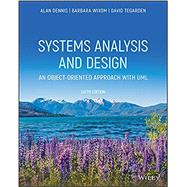Systems Analysis and Design: An Object-Oriented Approach with UML, Sixth Edition helps students develop the core skills required to plan, design, analyze, and implement information systems. Offering a practical hands-on approach to the subject, this textbook is designed to keep students focused on doing SAD, rather than simply reading about it. Each chapter describes a specific part of the SAD process, providing clear instructions, a detailed example, and practice exercises. Students are guided through the topics in the same order as professional analysts working on a typical real-world project.
Now in its sixth edition, this edition has been carefully updated to reflect current methods and practices in SAD and prepare students for their future roles as systems analysts. Every essential area of systems analysis and design is clearly and thoroughly covered, from project management, to analysis and design modeling, to construction, installation, and operations. The textbook includes access to a range of teaching and learning resources, and a running case study of a fictitious healthcare company that shows students how SAD concepts are applied in real-life scenarios.








